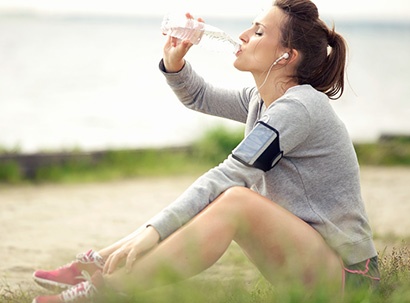When talking about an “aqueous solution” (water in our case), pH is a numeric scale used to describe how acidic or basic the solution is. The scale goes from 0 to 14, with the numbers on the lower end indicating greater acidity and those higher on the scale indicating greater basicity. A pH score of 7.0 is considered perfect. As the pH scale is logarithmic, the further you move away from 7 (either up or down), the more acidic or basic the water becomes.
And if you’re wondering about the acronym… “pH” is short for “potential hydrogen.”
There are many factors that affect water’s pH level. First is the rock and soil that it comes in contact with. That material can move water up or down the pH scale depending on its composition. Also influential is the amount of plant growth and organic material near a water source. Decomposition of plant matter causes the release of carbon dioxide, which increases acidity. Other factors like pollution and contamination play a role in water pH as well.
The pH level of water is crucial because it directly impacts your body's internal environment. By drinking water with a balanced pH, you are providing your body with the optimal conditions for cellular function and overall well-being. This is especially important for maintaining a healthy digestive system, promoting efficient nutrient absorption, and supporting a strong immune system.
The Environmental Protection Agency requires that the pH of drinking water (including the pH of natural spring water) be between 6.5 and 8.5.
Water that is too acidic has a corrosive quality and can be harmful to consume, in part because it may contain higher than recommended levels of iron, copper, lead, zinc, and other metals. It also is unpleasant to drink, as it has a bitter, metallic taste. What’s more, a diet high in acidity can result in weight gain, slower immune response, and susceptibility to disease.
Water that is more basic (i.e. it has a higher pH) doesn’t pose significant health risks, but it can be unpleasant to consume as well, tasting a bit like baking soda. In addition, it can form what is called “scale,” an unsightly film on plumbing and fixtures, dishes and utensils, etc. Plus, a diet that is too alkaline can lead to inability to metabolize key nutrients.
Pure water is considered to be neutral—right at 7 on the pH scale. This means that it is neither acidic nor basic, making it the perfect balance for your body's hydration needs. Eldorado Natural Spring Water maintains an average pH level of 7.33, which is almost a perfect score. This ensures that you are getting water that is not only pure but also optimized for your health and wellness.
So, whether you're quenching your thirst after a workout or simply enjoying a glass of water with a meal, choose Eldorado Natural Spring Water for a hydration option that goes beyond just quenching your thirst. With its superior pH level, our spring water is the perfect choice to nourish your body and keep you feeling refreshed throughout the day.

What are some ways to drink more?
*Content sourced from The Mayo Clinic
1783 Dogwood Street
Louisville, CO 80027
Phone: 303.604.3000
Fax: 303.499.1339